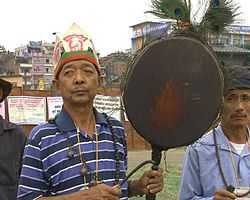Jhakri


Jhakri (Nepali: झाक्री) is the Nepali word for shaman. It is sometimes reserved specifically for practitioners of Nepali shamanism, such as that practiced among the Tamang people and the Magars. This word is also used in the Indian states of Sikkim and West Bengal, which border Nepal.
Jhakri shamanism is practiced among numerous ethnic groups of Nepal and Northeast India, including the Limbu, Rai Khambu, Sunwar, Sherpa, Kami, Tamang, Gurung, Magars and Lepcha.[1] Belief in spirits is prevalent, hence also the fear of spirit possession.[2] Some vernacular words for jhakri are phedangbo in the Limbu language, maangpa or nakchyong in Khambu, and boongthing in Lepcha.
Jhakris perform rituals during weddings, funerals, and harvests. They diagnose and cure diseases. Their practices are influenced by Hinduism, Tibetan Buddhism, Mun, and Bön rites.[3]
See also
- Banjhakri and Banjhakrini, shaman deities of Nepal
Notes
References
- Gulia, Kuldip Singh (2005). Human Ecology of Sikkim: A Case Study of Upper Rangit Basin. Delhi: Kalpaz Publications. ISBN 81-7835-325-3.